Recent Posts
-
And Yet, We Go On
April 22, 2024
-
It IS Happening Here
February 16, 2024
-
General Ludd to General Intellect
January 11, 2024
-
Temporal and Geographic Edges
December 26, 2023
-
The Root of All Evil
October 13, 2023
-
Post-Pandemic Melancholia . . . Same As It Ever Was?
September 3, 2023
-
Chronicle of Deaths Foretold
June 24, 2023
-
Reparations is the Least We Should Do
May 11, 2023
-
We Are Not Alone
April 9, 2023
-
War and Anti-War
February 22, 2023
|
Among my earliest memories in the late 1960s are anti-Vietnam war protests that I mostly experienced on TV. There was a cloud of teargas that wafted into my 6th grade classroom in North Oakland from the Governor Reagan-ordered National Guard assault on People’s Park protesters in Berkeley in 1969, but most of the upheavals of that era took place before I really came of age. By the time I was 15 in 1972, wondering if I would be drafted, the Vietnam War was winding down and the draft was soon abolished. During that time I had a class that focused for a month or two on “military justice,” emphasizing it as a quintessential oxymoron. I also heard about the U.S. role in the overthrow of Salvador Allende in Chile by way of FM radio newscasts that were great alternatives to the mainstream media (and exemplary of a time when the media’s hegemony and “truth” was being challenged from the grassroots left, not the aggrieved, resentful white right).
 Here’s a collage from 2003 just before the attack on Iraq, attributed to the Committee for Full Enjoyment. (Yes that’s me when I still had hair!) My political evolution through the 1970s into my early adulthood led me through anarchism (by way of the Spanish Civil War), anti-nuclear and pro-farmworker politics, and a consistent antipathy to the military. A bumper sticker of the era (that I had on my various vehicles) was white type on black background that mimicked the look of a contemporary ad for the U.S. Army: “Join The Army. Travel to exotic distant lands, meet exciting unusual people, and kill them.” When Reagan shockingly became president (surely he was too dumb and right-wing to be elected? Well, no), fired the Air Traffic Controllers and fired up the wars in Central America (and Grenada and Panama, plus backing Saddam Hussein in the 8-year Iran-Iraq war), local anti-war efforts focused on stopping arms shipments and halting the home-porting of the USS Missouri. When the Cold War collapsed in 1989, base closures followed, including nearly all the military properties in San Francisco and many around the bay. For a brief moment it seemed like maybe there was going to be a “peace dividend” and the long post-WWII slide into a military-industrial dominated society would begin to turn around.
 The bumper sticker of my 1970s As several of the books I look at here (see end for links) help to make clear, that didn’t happen, and it took a good deal of obfuscation and ideological gymnastics to ensure the continuity of the massive military budget when all the ostensible reasons for its maintenance were publicly disintegrating. David Vine in The United States of War has given us a detailed history of U.S. expansionism and empire from the pre-revolutionary colonial attacks on indigenous North America all the way to the recent offensive against ISIS in Syria (the book was published before the final collapse of the U.S. war in Afghanistan, now being carried on by Biden’s executive seizure of $7 billion in Afghan national assets, and ongoing punitive sanctions). Vine’s book is replete with informative maps that show each era of military-led expansion, first by building forts in other nation’s lands across the North American continent to facilitate western expansion and colonial subjugation of the first peoples, then seizing 1/3 of Mexico in the 1840s, and eventually the Philippines and a variety of islands in the Pacific and Caribbean by the turn of the 20th century, ending with a detailed look at the dramatic expansion of the U.S. military across the planet after WWII, with a less-known expansion of bases and hostilities across Africa since 2001.
It’s easy to imagine that the U.S. took a serious turn for the worse at various moments in history. A favorite of historians of a certain era was the seizure of the Philippines, Cuba, Puerto Rico, and Hawaii in 1898, ostensibly the first time the country became imperial in the manner of European states. But Vine is clear that that is a false understanding, and that there was never a period of U.S. history that wasn’t expansionist and covetous of neighboring (or far-flung) lands. Another moment some historians emphasize is World War II, and the fact that the U.S. was the only power physically stronger at the end of the war than at its outset. From its orchestration of a new world order in the post-war era, the United States embraced its new role as a pre-eminent superpower, though the Cold War competition with the Soviet Union became its explanation and rationale for its own militarism and incessant meddling. I never imagined the U.S. was anything but venal and ruthless in the 1950s, but Vine brought some statistics forward I hadn’t previously heard:
In a single year, 1958, the CIA led the government’s efforts to train more than five hundred thousand police officers in twenty-five nations, creating secret police units in nearly half and “strengthening repressive capacity” of undemocratic governments in particular. . . During his eight years in office, President Dwight D. Eisenhower authorized 170 major covert operations in forty-eight nations.
p. 201 and 202
Alfred McCoy in his latest To Govern the Globe: World Orders & Catastrophic Change offers a parallel list:
Between 1945 and 2000, the US intervened in 81 consequential elections worldwide, including eight times in Italy, five in Japan, and many more in Latin America. Between 1958 and 1975, military coups, many of them American-sponsored, changed governments in three dozen nations—a quarter of the world’s sovereign states—fostering a distinct “reverse wave” in the global trend toward democracy.
p. 227
I’ll come back to Vine a bit later when I return to the sheer madness of the economic side of this imperial project. But before that, it’s important to delve into its twisting self-justifications, which from the early days of the Cold War went through an Orwellian rebranding from war to defense, using deeply rooted definitions of the liberal self to render the brutal truth of a militarized empire largely invisible.
Joseph Darda has a great book called Empire of Defense—Race and the Cultural Politics of Permanent War. It’s probably one of the best treatments of the logic of U.S. militarism and foreign policy I’ve read (even though I just went through the eight books listed at the end during the past six weeks—along with several others!—there are dozens of books on these topics that have been published in the past few years). I would put Darda’s book as a bookend with Stephen Mexal’s book on 19th century western liberalism that I discussed way back in 2014. Darda lays out how President Truman reorganized the military establishment in 1948, changing the Department of War to the Department of Defense, creating the National Security Council and the NSA, the CIA, and the foundations for the expansive spook bureaucracies we now have (though we have little conscious idea of what they do with the hundreds of billions of secret money they spend every year). But the U.S. was inheriting the role of defending a colonial world order, but knew it had to do it while seeming to be anticolonial. The deep Jim Crow racism of WWII-era US life was a problem internationally, and when prominent Black activists submitted a document to the United Nations called “We Charge Genocide” against the United States, it set off urgent efforts to reframe the US role in the world. Here’s Darda’s main argument in a nutshell:
There is nothing aberrational about racism in the United States. It is woven into the American creed. Liberalism defines the human by universalizing the characteristics of white Western man and valuing all others based on their adoption of, or failure to adopt, his characteristics. It defines humanity through inclusion but also through the violence of assimilation and exclusion, securing the liberal freedoms of some by looting the land and labor of others . . . The liberal state, facing a rising anticolonial tide, constructed a color-blind color line through the idea of defense…. But defense also means defining who does and doesn’t count as mankind. Defense is a racial regime through which the state distinguishes between the human with the right to self-defense, the deferred human to be assimilated, and the nonhuman to be killed . . . The collapse of colonialism and the erosion of Jim Crow threatened to undo a world long governed by white Western men. The empire of defense contained the emerging crisis by criminalizing those threatening to change that world, turning Asia and Africa into a crime front and black and brown America into a war front. It policed the crisis through repression but also by reform and, by preaching anticolonialism and antiracism, made it difficult to tell the difference.
p. 12, 13, and 23
And Darda is clear that from Truman onward, the line between war and policing has been blurring continuously. Both the Korean and Vietnam Wars were defined as “police actions” at the start. Eventually the efforts to police drugs turned into the War on Drugs. Essentially policing and war-making are two sides of a process whereby elites create boundaries between legitimate and illegitimate ways of living. By the time the Cold War ended in 1989, the Drug War had been a major activity for the military in Central America and the heavily militarized police inside the U.S. itself. Darda shows how the first Gulf War (and the ensuing bombings of Somalia and Serbia in the 1990s) were framed as “humanitarian wars,” a rationale trotted out on behalf of the women of Afghanistan and the suffering masses of Iraq, too, in the first decades of the 21st century.
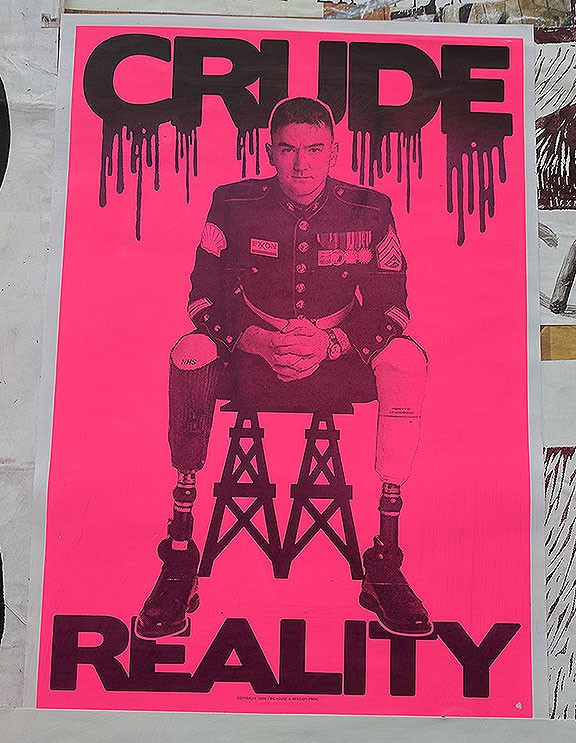 One of many images on our Democracy Wall on the former police station on Valencia Street. Continue reading Refusing to be an Imperial Subject
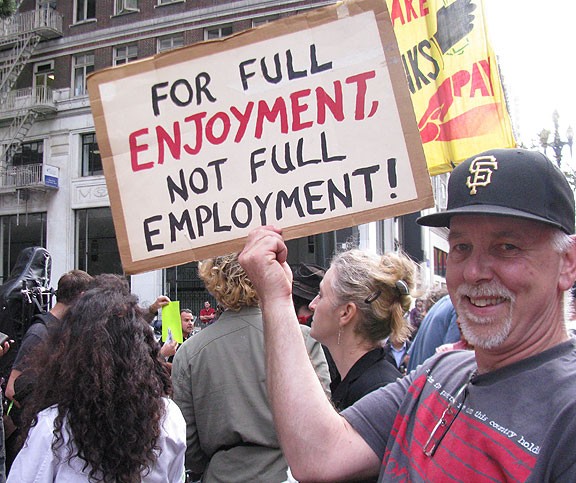 A few years ago… still relevant! It’s the end of the year 2021. Expectations of an end to life as we knew it—resulting from the pandemic—have not materialized. Even the end of the pandemic has not materialized, though just a few months ago it seemed it was winding down. Climate change continues to barrel down on us with no sign that the death-grip of the fossil fuel industries is loosening its hold on the political class. At least we’ve had a miraculously wet and snowy December in northern California, delaying by another season the relentless drying out that will eventually turn much of California into a desert.
I’ve written in previous posts about the ruminations of Franco “Bifo” Berardi. His latest book, The Third Unconscious, sparked my curiosity. Like previous recent books, he is trying to find a path out of the depressive world of semiotic capitalism we’re all trapped in. His earlier analysis of the replacement of conjunction by connection (essentially the swapping of face-to-face lived experience for the programmed communications of online “connection”) provides some foundation for his new effort to understand what is happening to our deeper sense of life during these pandemic times. He recognizes that there is a deep division underway, a cultural split that gets the name “schismogenesis,” meaning a deliberate differentiation, where different populations assert their difference from each other. (Graeber and Wengrow make use of this term in The Dawn of Everything too, referring to the apparent common reality that people who live near each other tend, over time, to choose opposite traits and qualities of the other.) In Bifo’s book, he is referring to the emergent culture that, if it finds its collective voice, if its subjectivity emerges, may lead to a revolution worthy of its name. As he notes, as a result of the pandemic’s abrupt alteration of the rhythms of daily life,
…we have moved beyond the labyrinth; we have silently made that move that fifty years of loquacious struggles have failed to carry out. The disruption has finally happened, but it has been a process without subjectivity. (p. 39)
In his most optimistic moments he says things like
They [we?] are weaving the fabric of the emergent cosmos that may become recognizable beyond the threshold: that new cosmos which is already schismogenetically diverging from the dying form of the old cosmos, from the chaotic trap of the rules that used to hold the world together by destroying it. (p. 12)
… an alternative does exist: it is based on the liberation from the obsession with economic growth; it is based on the redistribution of resources, on the reduction of labor time, and on the expansion of time dedicated to the free activity of teaching, researching, healing and taking care. (p. 130)
Elsewhere he notes that “it is impossible to separate climate justice from a world-wide program of redistribution of wealth and resources,” which if we were to abandon the mythology of expansion and endless growth, would allow us to “adopt a frugal, egalitarian culture. No more useless goods to ingest, but more time to enjoy with our friends, our lovers: this is frugality.” (p. 149)
But I think The Third Unconscious is ultimately a book about the End, that is death. He thinks a lot about it, probably because he’s nearing the end of his own life, and the dramatic hopes that he helped bring to life in the late 1970s in the Italian Autonomia movement have long been relegated to the sidelines. For Bifo, and from his point of view for all of us, “Exhaustion has taken the place of expansion.”
Bifo is hardly the first philosopher to ruminate about death as they approach their own. But given the global pandemic, climate change, and the existential malaise that he has long argued is a logical outcome of the hyperstimulation and exhaustion of human consciousness and planetary ecology that the 21st century has imposed on us, our extinction is no longer inconceivable. He locates a particular madness in the recent surge of nationalism, which he attributes to a general impotence of the will facing the many crises we can’t seem to act on, so his conclusion is to propose that we “consciously assume extinction as the horizon of our time.”
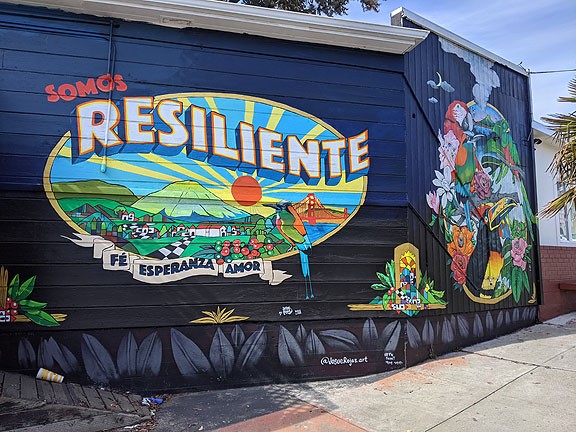 Josue Rojas’s lovely mural at the southern edge of San Francisco. The end of the world is one path. But worlds have ended many times previously. What has colonialism wrought if not the utter destruction of whole worlds? Bifo is clear about this:
…The end of the world consists in the dissolution of the cultural context that makes experience meaningful, shareable. Colonialism has already provoked many ends of the world. Why should we be surprised if the final collapse of colonialism (that some call postcolonialism) coincides with the end of the world itself? … The peoples of the Global South, the native people of the American continents, the Australian aboriginals, the African communities hit by slave deportation, and many others have already known the experience of extinction, when colonization destroyed the context in which common experience was meaningful. (p. 98-99)
When I read this I found it startlingly on point. Another recent book that I highly recommend is Bad Indians: A Tribal Memoir by Deborah Miranda (Heyday Books: 2013). It’s an incredible kaleidoscopic, emotional, sardonic, wry, and poignant excavation of her own family history as well as a broader look at the history of California Indians.
The original acts of colonization and violence broke the world, broke our hearts, broke the connection between soul and flesh. For many of us, this trauma happens again in each generation, to children too young and too untrained to try to cope with dysfunction that ravages even adults… the formation of a Mestiza Nation was as much about healing from our childhoods as healing from larger histories. I am of the seventh generation since my great-great-great-great-great-great-grandparents Fructuoso Cholom and Yginia Yunisyunis emerged from Mission San Carlos de Borromeo in Carmel, California, in the mid-1830s. I am half white, half Indian, mixed with Mexican and Jewish tribes. (p. 123)
If we allow the pieces of our culture to lie scattered in the dust of history, trampled by racism and grief, then yes, we are irreparably damaged. But if we pick up the pieces and use them in new ways that honor their integrity, their colors, textures, stories—then we do those pieces justice, no matter how sharp they are, no matter how much handling them slices our fingers and makes us bleed. (p. 135)
The dire stories of her childhood and long journey to this self-awareness make this book a very compelling read. The tone she strikes is exactly the note I’ve been encountering more frequently in the past two years than ever before—that California Indians are still here, perhaps in fragmented and sometimes hybrid identities, but actually thriving and growing in ways that have an important role to play in shaping our collective future. While some may follow European intellectual tradition(s) into the cul-de-sac of despair and resignation, people with a lot more justification for despair keep finding ways to reconnect to the generational flow that wasn’t vanquished, did not end, and is creatively forging a new future.
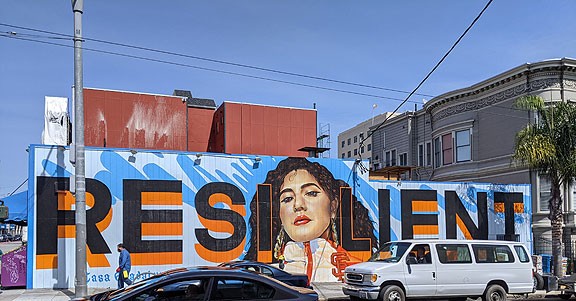 A recurring theme… Continue reading The End
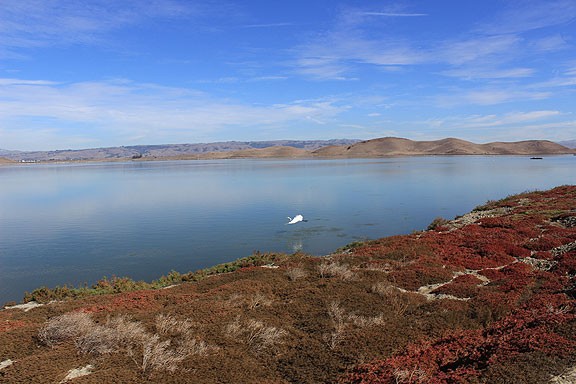 A heron glides across the wetlands off Coyote Hills Regional Park in the south bay, 2014. “…were civilization itself to be estimated by some of its results, it would seem perhaps better for what we call the barbarous part of the world to remain unchanged.” —Herman Melville, 1846, Typee: A Peep at Polynesian Life
I’m not a “professional” historian—I didn’t go to college to study history, and never even graduated with an undergraduate degree. As a long-ago college dropout I had the freedom to browse topics and follow my curiosity wherever it led me, and now, almost a half century later, I have read a great deal, and know a lot about a lot. But I’m not delusional, and the main lesson of all this history reading, history making, writing, discussing, and presenting, is an acute awareness of how little I know. Knowing a lot and practically nothing at the same time prepared me perfectly for the book I’m going to write about today.
In the past few years, if you’ve been reading this blog, you’ll know that my interests, starting with my early focus on (the stupidity of most) work and (our deteriorating) ecology, generally San Francisco and California-focused, have been turning more broadly to early American history. Especially the histories that have been emerging of indigenous “Americans” in both north and south America (and the horrifying genocides they were subjected to), and the role of Africans who were brought here in slavery, and have been at the heart of continental history ever since. I have been seeking some deeper sense of the continuities that carry those harsh precedents into our current lives. As always I’ve been reading a lot, and had the pleasure and genuine amazement of reading the just-released The Dawn of Everything: A New History of Humanity by David Graeber and David Wengrow (The Davids from here).
I blogged a few posts ago about my pal Annalee Newitz’s fascinating book on Four Lost Cities: A Secret History of the Urban Age, but The Davids have gone considerably further and deeper (and much longer). There are so many different themes that emerge from The Dawn of Everything that it is a challenge to present the book’s topic in any simple summary (like Annalee they take on the question of how and when cities emerged, but they do so much more too). There are parts of this book that I was particularly moved by, especially the gap-filling history of North America between the common idea of migration from Asia at the end of the last Ice Age thousands of years ago to the arrival of Europeans a little over 500 years ago. By unpacking that lost history using solid archaeological and anthropological evidence they debunk our common acceptance of a stadial, or stage-ist, understanding of “civilization”—where we go from cave dwellers to hunting and gathering nomadism to sedentary villages where agriculture develops, followed by mining, and the emergence of hierarchy, power, accounting, etc. and eventually leading to cities, empires, and states (“inevitably” producing the world we’re in today, a globalized concoction of militarized states protecting the concentrated wealth of multinational corporations and their owners, straddling a global population nearing 9 billion)… While all these things happened at different places and different times, The Davids are very convincing at changing the lens, at flipping our focus to look at the thousands of years in which early agriculture (or “play farming” as they cleverly call it) is part of life but doesn’t lead to any of the next steps that are supposedly locked in by the emergence of cultivated grains and domesticated animals.
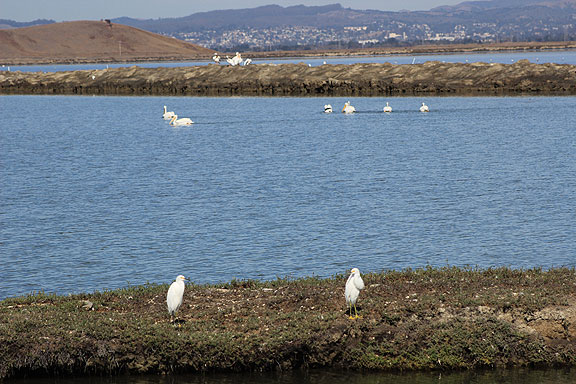 Pelicans and egrets on the still abundant wetlands of the south bay, 2014. …our remote forager ancestors were much bolder experimenters in social form, breaking apart and reassembling their societies at different scales, often in radically different forms, with different value systems, from one time of year to the next. The festive calendars of the great agrarian civilizations of Eurasia, Africa and the Americas turn out to be mere distant echoes of that world and the political freedoms it entailed.
p. 120
Near the end of the book they re-emphasize one of their main points:
…what happens if we accord significance to the 5,000 years in which cereal domestication did not lead to the emergence of pampered aristocracies, standing armies or debt peonage, rather than just the 5,000 in which it did? What happens if we treat the rejection of urban life, or of slavery, in certain times and places as something just as significant as the emergence of those same phenomena in others? … the periods in which free or relatively free societies existed are hardly insignificant. If you bracket the Eurasian Iron Age (which is effectively what have been doing here), they represent the vast majority of human social experience.
p. 523
The Davids spend a few chapters digging deeply into the history of the cultures that Europeans first encountered in the eastern woodlands of North America. Many people have heard a passing reference to the idea that the US Constitution and governmental structure was inspired in part by the Haudenosaunee Confederation of Six Tribes (commonly referred to as the Iroquois, consisting of Mohawk, Seneca, Cayuga, Onandaga, Oneida, and Tuscarora). But The Davids found a fascinating historical character in a Wendat leader (aka Huron) named Kondiaronk, who was so admired for his oratory and ability to discuss and argue that he was repeatedly invited to dine with the French governor of Montreal in the late 1600s. A lesser French dignitary named Baron Louis Armand Lahontan (1666-1716), who later fell on hard times and was exiled in Amsterdam, witnessed many of Kondiaronk’s public debates and wrote a bestselling book in the early 1700s that The Davids convincingly argue is based on his notes taken from those discussions. Even Wikipedia has posted an excerpt from The Dawn of Everything with this remarkable exchange:
Kondiaronk: I have spent 6 years reflecting on the state of European society and I still can’t think of a single way they act that is not inhuman and I generally think this can only be the case as long as you stick to your distinctions of “mine” and “thine.” I affirm that what you call “money” is the devil of devils, the tyrant of the French, the source of all evils, the bane of souls and slaughterhouse of the living. To imagine one can live in the country of money and preserve one’s soul is like imagining one can preserve one’s life at the bottom of a lake. Money is the father of luxury, lasciviousness, intrigues, trickery, lies, betrayal, insincerity—of all the world’s worst behavior. Fathers sell their children, husbands their wives, wives betray their husbands, brothers kill each other, friends are false—and all because of money. In light of all of this, tell me that we Wyandotte are not right in refusing to touch or so much as look at silver.
Do you seriously imagine that I would be happy to live like one of the inhabitants of Paris? To take two hours every morning just to put on my shirt and make up? To bow and scrape before every obnoxious galoot I meet on the street who happens to have been born with an inheritance? Do you actually imagine I could carry a purse full of coins and not immediately hand them over to people who are hungry? That I would carry a sword but not immediately draw it on the first band of thugs I see rounding up the destitute to press them into Naval service? If on the other hand, Europeans were to adopt an American way of life, it might take a while to adjust but in the end you will be far happier.
Calliére: Try, for once in your life to actually listen. Can’t you see, my dear friend, that the nations of Europe could not survive without gold and silver or some similar precious symbol? Without it, nobles, priests, merchants and any number of others who lack the strength to work the soil would simply die of hunger. Our kings would not be kings. What soldiers would we have? Who would work for Kings or anyone else?
Kondiaronk: You honestly think you’re going to sway me by appealing to the needs of nobles, merchants, and priests? If you abandoned conceptions of mine and thine, yes, such distinctions between men would dissolve. A leveling equality would take place among you, as it now does among the Wyandotte and yes, for the first thirty years after the banishing of self-interest no doubt you would indeed see a certain desolation as those who are only qualified to eat, drink, sleep, and take pleasure would languish and die, but their progeny would be fit for our way of living. Over and over I have set forth the qualities that we Wyandotte believe ought to define humanity: wisdom, reason, equity, etc. and demonstrated that the existence of separate material interest knocks all these on the head. A man motivated by interest cannot be a man of reason.
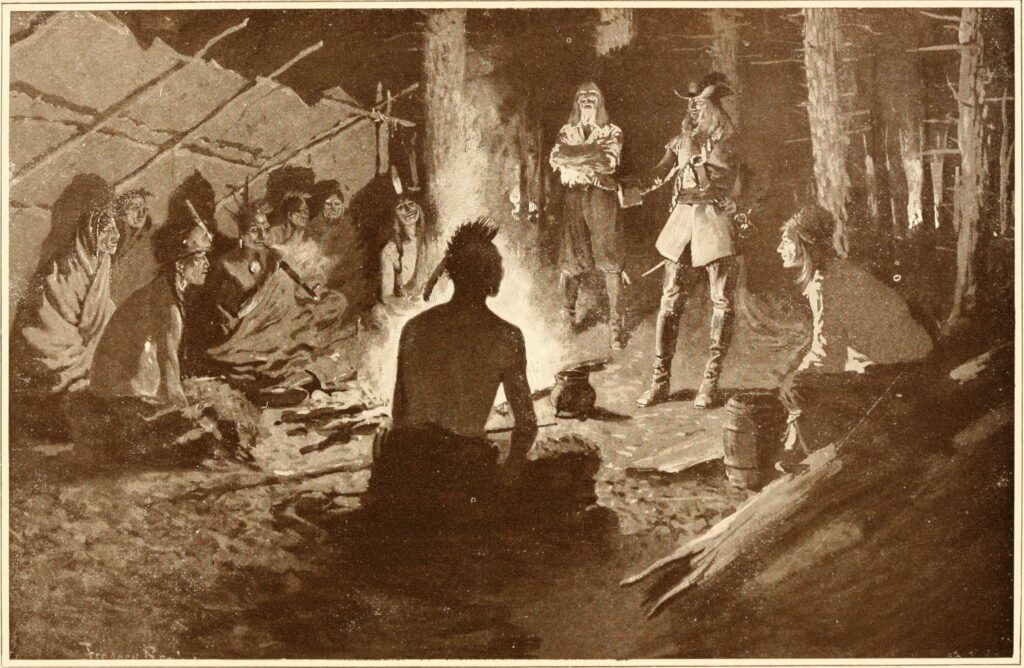 Fanciful rendition of Kondiaronk speaking to captured Iroquois diplomats in 1688. (from Indian history for young folks published in 1919) (from Wikipedia) This exchange is fascinating in itself. But the authors show that this kind of public debate was made widely known by books published in the early 1700s in Europe. As the years went by, the ideas represented were transformed from arguments made by real humans disgusted by European life into staged dialogues in which the unquestioning Christian interlocutor would be clearly out-argued by his “savage” opponent, but then would end with the knowing shrug that these ideas could only prevail among primitive people who had no better idea. The Davids argue that over some decades this led to the first articulation of the idea of Progress by Turgot in 1750, which was key to dismissing the by then well-known critique of European civilization precisely because the Europeans were self-evidently at the cutting edge of Progress. The French Revolution, based on the new ideas of liberty and individual freedom, mutual aid and the “brotherhood of man,” which was partly instigated by the prevailing new rationalist paradigms of the Enlightenment, can be traced back 100 years to these confrontations between monotheistic, divine-right monarchist Europeans and the divergent, autonomous, consultative, and anti-authoritarian cultures of North America.
Continue reading Civilization and Its Forgotten (and Suppressed) Possibilities
|
|




















